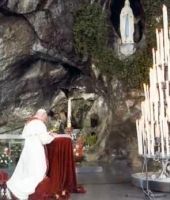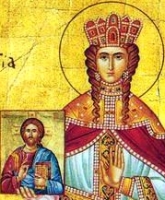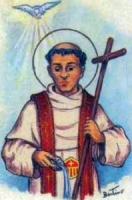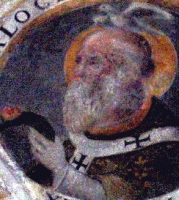| 11 February |
• yesterday • tomorrow |
| Optional Memorial of Our Lady of Lourdes |

The memorial commemorates the eighteen (18) apparitions of the Blessed Virgin Mary to Saint Bernadette Soubiroux that occurred between 11 February and 16 July of 1858 near the town of Lourdes in the Hautes-Pyrenees region of France. Though there would be other people with her, only Saint Bernadette could see the Lady.
During the 9th appearance, on 25 February, the Lady told Bernadette to drink from a spring that suddenly appeared in the grotto where the apparitions occurred. During the 12th appearance, on 1 March, a visitor washed her arm in water from the spring, and some nerve damage in it was immediately cured. There is a tradition of miraculous cures at the grotto, or received by those who drink or are bathed in its waters. Bernadette later said that the water had no special properties, but it helped focus the faithful who received the cures through faith and prayer.
During the 13th appearance, on 2 March, the Lady told Bernadette to tell local priests that they should build a chapel at the grotto, and have processions to be made to it; the priests were understandably skeptical, but due to the numbers of pilgrims coming to the area, construction of several churches was started within a few years.
During the 16th appearance, on 25 March, the Lady identified herself as "the Immaculate Conception".
Due to the number of people gathering at the site, and making treks to the area, on 8 June 1858, the mayor of Lourdes barricaded the grotto and stationed guards to prevent public access; visitors were fined for kneeling near the grotto or talking about it, and Bernadette saw the last appearance of the Lady from outside the barricade. The grotto was re-opened to the public in October 1858 by order of Emperor Louis Napoleon III, and the pilgrims have not stopped coming since.
• on 18 January 1862 Bishop Bertrand-Sévère Mascarou-Laurence, with the authorization of Pope Pius IX, declared that the faithful are "justified in believing the reality of the apparition"
• national French pilgrimages to the site began in 1873
• the basilica of Notre-Dame de Lourdes was consecrated in 1876
• Pope Pius IX formally granted a canonical coronation to the statue of Our Lady in the courtyard of the basilica on 3 July 1876
• Church of the Rosary consecrated in 1901
• a special office and Mass were authorized by Pope Leo XIII
• observance of the feast extended to the whole Church by Pope Pius X in 1907
• sick people
• France
• Tennessee
• Lancaster, England, diocese of
• 6 cities
https://catholicsaints.info/our-lady-of-lourdes/

A feast instituted on 13 May 1992 by Pope John Paul II to be "a special time of prayer and sharing, of offering one's suffering". The date of the feast, 11 February, was chosen to coincide with that of Our Lady of Lourdes as there have been so many healings reported at the shrine and through Our Lady's intercession. Pope Benedict XVI announced his resignation on this feast day in 2013, citing his declining health as his reason.
https://catholicsaints.info/world-day-of-the-sick/

• Gregory the Younger
• Gregory Junior
Involved in Church affairs from an early age. Pope Saint Sergius I ordained Gregory a sub-deacon. He served the next four popes as treasurer of the Church, then librarian. Assigned important missions. Accompanied Pope Constantine to Constantinople for discussions with Emperor Justinian II.
Elected 89th pope in 715. He held synods to correct abuses, stopped heresy and promoted discipline and morality in religious and clerical life. Rebuilt a great portion of the walls of Rome, Italy to protect the city against the Lombards. Restored churches, cared for the sick and aged, re-established monasteries and abbeys. Consecrated Saint Boniface and Saint Corbinian as missionary bishops to the tribes in Germany. English pilgrims increased to the point that they required a church, cemetery, and school of their own.
In his dealings with Emperor Leo III, Gregory's showed strength and patience. Leo demanded destruction of holy images. When bishops failed to convince him of his error, they disobeyed and appealed to the Pope. Gregory tried to change the emperor's thinking, counseled the people to maintain allegiance to the prince, and encouraged the bishops to oppose the heresy. It appears he won out.
669 at Rome, Italy
19 May 715
11 February 731 at Rome, Italy of natural causes
• Pope Gregory II Commends Bishop Boniface to the Christians of Germany
• Pope Gregory II Gregory Invests Boniface with Episcopal Authority
• Pope Gregory II Commends Boniface to the Leaders of Thuringia
• Pope Gregory II Commends Boniface to Charles Martel
• Pope Gregory II Commends Boniface to the People of Thuringia
• Pope Gregory II Replies to Questions Put by Boniface
• Pope Gregory II Invests Boniface with the Pallium
https://catholicsaints.info/pope-saint-gregory-ii/

Cædmon, Cadfan, Cedmon
A layman cowherd, in his later years he came to work with animals at the double monastery of Whitby. One night in 657 he received a vision which commanded him to glorify God with hymns, and which gave him the poetic skills to do so. As he was illiterate, the brothers would read the Bible to Caedmon, and he would repeat it back to them as poetry. With the encouragement of Saint Hilda, Whitby's abbess, he became a Columban lay brother. First known poet of vernacular English. His story was recorded by Saint Bede. Miracles attributed to his intercession.
• in the British Isles
• may have been Celtic
• c.670 at Whitby, Yorkshire North Riding, England of natural causes
• probably buried at Whitby
cattle, harp, dove, music
Wherefore, being sometimes at feasts, when all agreed for glee's sake to sing in turn, he no sooner saw the harp come towards him than he rose up from the board and went homewards. Once, when he had done this and gone from the feast to the stable, where he had that night charge of the cattle, he laid himself down to rest at the proper time and there appeared to him in his sleep one who said, greeting him by name, "Caedmon, sing some song to me."
"I cannot sing," he answered, "and for that reason I left the feast and came hither, because I could not sing."
He who talked with him answered, "However that may be, you shall sing to me."
"What shall I sing?" rejoined Caedmon.
"Sing the beginning of created things," said the other. Having received this answer, the abbey's cowherd began to sing, to the praise of God the Creator, verses which he had never heard before, and afterwards awaking from his sleep, he remembered all that he had sung in his dream and added more to the same effect in verse worthy of the Deity. - Saint Bede
Now we should praise
the heaven-kingdom's guardian,
the measurer's might
and his mind-conception,
work of the glorious father,
as he each wonder,
eternal Lord,
instilled at the origin.
He first created
for men's sons
heaven as a roof,
holy creator;
then, middle-earth,
mankind's guardian,
eternal Lord,
afterward made
the earth for men,
father almighty.
- translation of "Hymn of Creation" by Caedmon, the hymn he learned in his vision
Let us now praise the Guardian of the Kingdom of Heaven and the might of the Creator,and the thought of His Mind, glorious Father of men; for He, Lord Eternal, did frame the beginning of every marvellous thing. He first made the heavens as a roof for the children of men, God, the Creator! Then the mid-earth did the eternal Lord, the Guardian of men, therewith provide, and earth for men, the Lord God Almighty! - Saint Caedmon
https://catholicsaints.info/saint-caedmon/

• Francisco Borrás Romeu
• Tobias Borrás Román
• Tobias Borrás Romeu
• 24 November (listed on some calendars due to confusion over the date of his death in some of the beatification paperwork)
• 30 July as one of the Martyred Hospitallers of Spain
Married in 1884 at age 23, he became a widower when his wife died in the cholera epidemic of 1885–1886. He joined the religious in the Hospitallers of Saint John of God in 1887. He served in Hospitaller communities in the Spanish cities of Ciempozuelos, Zaragoza, Carabanche Alto and Granada where his superiors noted his generous spirit and willingness to work.
As part of the anti–Catholic persecutions of the Spanish Civil War, Brother Tobias was imprisoned in Ciempozuelos and then transferred to San Antón in Madrid, Spain. Due to his age and failing health, he was eventually released. He travelled to Valencia, Spain, planning to joined up with the Malvarrosa Hospitallers community - unaware that they had all already been murdered. He knocked on the door their house, was recognized by the militia as another Hospitaller, and shot down. Martyr.
14 April 1861 in San Jorge, Castellón, Spain
shot on 11 February 1937 at the Hospitaller community just outside the city of Valencia, Spain
25 October 1992 by Pope John Paul II
https://catholicsaints.info/blessed-tobias-francisco-borras-roman/

Son of Bonosus. Studied at the Lateran Basilica in Rome, Italy. Benedictine monk. Abbot of Saint Stephen's monastery, which was near the Vatican, and which housed pilgrims to Rome. Elected 98th pope in 817.
Defended the Greeks against iconoclastic emperors, and sheltered refugees from the iconoclast persecutions. Supported Saint Nicephorous and Saint Theodore Studites. Enshrined the relics of Saint Caecilia and other martyrs.
When two papal officials were found blinded and murdered, Paschal was accused of the crime. He was not involved, but the murderers were members of his household, and he refused to surrender them, claiming that the victims were traitors, and that secular authorities had no jurisdiction over events that occurred within the Vatican. The dispute resulted in the Constitution of Lothair, which set specific limits on the law enforement and judicial powers of the pope.
at Rome, Italy
25 January 817
824
https://catholicsaints.info/pope-saint-paschal-i/
Cistercian monk at the abbey of Clairvaux. Spiritual student of Saint Bernard of Clairvaux. Like many others from that house, he went out to establish other houses, and c.1150 travelled to the Nordic countries. There he became abbot of Varnhem Abbey in Sweden, but when Queen Christina Björnsdotter sought to take over their property, Henry left to seek help from other houses. He reached Roskilde, Zealand, Denmark during a synod led by Archbishop Eskil of Lund. Eskil was so impressed with Henry, and so sympathetic to his problem, that he recommended him to lead a monastery that King Valdemar was planning to build. Henry became the first abbot of Vitskøl Abbey, and brought many of his harassed brothers from Sweden to live there. Most eventually returned to Varnhem when the pressures against their house ended, but Henry continued to lead the house of Vitskøl, making it a regional center of piety and learning, and a source of medical herbs.
12th century France
https://catholicsaints.info/blessed-henry-of-vitskol/

21 May as one of the Martyrs of the Mexican Revolution
Parish priest in Santa Isabel, archdiocese of Chihuáhua, Mexico. Beaten and martyred in the anti-Catholic persecutions of the Mexican Revolution.
15 June 1892 in Chihuáhua City, Chihuáhua, Mexico
11 February 1937 in Chihuáhua City, Chihuáhua, Mexico from a gunshot in the forehead the day before
21 May 2000 by Pope John Paul II
https://catholicsaints.info/saint-pedro-de-jesus-maldonado-lucero/

Anselm of Steingaden
Soldier. Premonstratensian monk. Canon at the monastery of Mönchsrot in Rot an der Rot near Memmingen, Oberschwaben, Baden-Württemberg (in modern Germany). Spiritual student of Blessed Odino of Rot. Founding abbot of the monastery in Steingaden, Weilheim-Schongau, Bavaria (in modern Germany) in 1147; it became a center for learning, and was known for the piety of its monks, and their strict adherence to the Premonstratensian Rule.
12th century Germany
11 February 1162 in Steingaden, Bavaria, Germany
https://catholicsaints.info/blessed-anselm-of-rot-an-der-rot/

• Castrensis of Sessa
• Castrensis of Campania
• Castrensis of Africa
• Castrense, Castrese, Castrenze
1 September as one of the Exiles of Campania
Priest. Bishop exiled from Africa to Italy in the 5th century by Arian Vandals. Bishop of Capua, Italy.
relics at Capua, Italy and in Monreale, Sicily
• Castel Volturno, Italy
• Marano di Napoli, Italy
• Monreale, Italy, city of
• Monreale, archdiocese of
• San Castrese di Sessa Aurunca
https://catholicsaints.info/saint-castrensis/
Echen, Ecian, Eciano, Éidchéan, Etchenius
Monk. Founded a monastery in Clonfad, Leinster, Ireland, and served as its abbot. Bishop, based at the monastery. Ordained Saint Columba of Iona; legend says that Columba was so eager to start his vocation that Etchen had to stop in the middle of plowing a field to perform the ordination.
490 in Ireland
• 11 February 577 of natural causes
• buried in the cemetery at Clonfad, Ireland
• some relics in the church at Clonfad
• farmers
• plow-men
https://catholicsaints.info/saint-etchen-of-clonfad/
• Lucius of Edirne
• Lucius of Odrin
• Lucius of Edrêne
• Lucius of Jedrene
• Lucius of Hadrianopolis
Bishop of Adrianople. Spoke zealously against Arianism at the Council of Sardica in 343; the feelings against orthodox Catholics were so strong that the Arian emperor Constantius agreed that Lucius was under the protection of Pope Julius before the bishop could return home after the Council. However, he and many of his flock were later martyred by Arians.
c.348 in the diocese of Adrianople (modern Edirne, Turkey)
https://catholicsaints.info/saint-lucius-of-adrianople/

Abigail, Albina, Deborah, Gobnat, Gobnet, Gobnait
Sixth century abbess of a convent at in Ballyvourney, Ireland. A holy well there that is named for her still exists. Legend says that she found the site of the convent by chasing a white deer; an angel told her to follow it until she found a herd of nine white deer and found her house there.
https://catholicsaints.info/saint-gobnata/
Elisa, Eloisa, Heloise, Helvisa
Born to the French nobility. Married to Count Hugh of Meulan. Widowed. Donated a large part of her inheritance to the nearby Benedictine abbey of Notre-Dame in Coulombs, France. She married again but was soon widowed a second time and decided to renounce all worldly life. She spent the rest of her days as an anchoress in a cell attached the basilica and under the spiritual direction of the abbey in Coulombs, but never joined the Order.
• c.1060 of natural causes
• relics enshrined in the abbey at Coulombs, France
https://catholicsaints.info/blessed-helwisa/
• Anonymous Martyrs in Africa
• Martyrs of Africa
• Martyrs of Numidia
• Martyrs of the Holy Books
A large number of Christians tortured and murdered in Numidia (part of modern Algeria) during the persecutions of Diocletian, but whose names and individual stories have not survived. They were ordered to surrender their sacred books to be burned. They refused. Martyrs.
c.303 in Numidia
https://catholicsaints.info/guardians-of-the-holy-scriptures/
Dubhán
Son of Saint Brychan of Brycheiniog and Din, a Saxon princess, Duban received a good education in the faith, and was ordained a priest. Around the year 452, Duban travelled to Ireland to make pilgrimages to holy sites. Founded a church at Killooaun or Cill Dhubháin (“the church of Dubhán”) which became an important site at the time, but which is in ruins 1600 years later.
mid-5th century in the British Isles
early 6th century Ireland of natural causes
https://catholicsaints.info/saint-duban/
Ardagne, Ardagno, Ardagnus, Ardain, Ardaing, Ardan
Benedictine monk. Abbot at Tournus, diocese of Autun, France. Restored monastic buildings there, and cared for the local people during the famine of 1030 to 1033.
• c.1057 of natural causes
• relics enshrined in a chapel dedicated to his at the church of the abbey of Saint Philibert at Tournus, diocese of Autun, France in 1140
• relics burned by Huguenots in 1562
https://catholicsaints.info/saint-ardanus-of-tournus/

Empress, married to the brutal and thuggish Emperor Theophilus; mother of Emperor Michael III. Widowed, she immediately put an end to the iconoclast persecutions. She governed the empire for 12 years but was banished when her drunken son took the throne, and spent the last eight years of her life in a monastery.
867 of natural causes
https://catholicsaints.info/saint-theodora-the-empress/
Married, when she was widowed, Bertrada joined a cloister in the church of Saint Magnus in Saint Gallen, Switzerland. Her reputation for holiness spread, which led to people seeking her spiritual wisdom, which then led her to move to a hidden cell near the church of Saint George c.960 where she lived the rest of her days as a hermitess.
c.983 of natural causes
https://catholicsaints.info/blessed-bertrada-of-saint-gallen/

Born to the nobility, and taught orthodox Christianity during the period of the Arian heresy. Monk. Abbot in Agaunum (modern Saint-Maurice-en-Valais, Switzerland).
Burgundy, France
c.507
https://catholicsaints.info/saint-severinus-of-agaunum/
Nun in the Archdiocese of Madrid, Spain. Member of the Daughters of Charity of Saint Vincent de Paul. Martyred in the Spanish Civil War.
12 February 1878 in Valdemorillo, León, Spain
11 February 1937 in Vistillas, Madrid, Spain
27 October 2013 by Pope Benedict XVI
https://catholicsaints.info/blessed-gaudencia-benavides-herrero/

Mercedarian priest. The first missionary priest in Mexico, arriving in 1516, travelling with Cortés and working with the Aztecs.
• November 1524 in Mexico
• buried in Santiago de Tlaltelolco
https://catholicsaints.info/blessed-bartholomew-of-olmedo/
Pietro de 'Pasquali
Franciscan friar. Travelling preacher in the regions of Piedmont in modern Italy, Provence in modern France, and then into Spain where he met with resistance from heretics. Martyr.
Cuneo, Italy
11 February 1322 in Valencia, Spain
https://catholicsaints.info/blessed-pietro-of-cuneo/

Calogero, Caio, Calocero
Spiritual student of Saint Apollinaris of Ravenna. Bishop of Ravenna, Italy.
Greek
c.130
https://catholicsaints.info/saint-calocerus-of-ravenna/
Silplicius, Simplice, Simplicidius, Simplicio, Simplides, Simplidis
Bishop of Vienne in the Dauphiné in southeast France in 398, serving the remaining 19 years of his life. Martyred by pagan Germans.
417
https://catholicsaints.info/saint-simplicius-i-of-vienne/
• Jonas of Demeskenyanos
• Jonas the Gardener
Fourth century monk at Demeskenyanos, Egypt. Spiritual student of Saint Pachomius of Tabenna. A gardener by day, a rope plaiter by night, he worked for his monastic community for 84 years.
https://catholicsaints.info/saint-jonas-of-muchon/
Sotere, Soteris, Sotra
Young woman martyred for refusing to sacrifice to idols. Related to Saint Ambrose of Milan who wrote about her.
Rome, Italy
beheaded on 11 February 305 on the Via Appia, Rome, Italy
https://catholicsaints.info/saint-soter-of-rome/
During the persecutions of Diocletian, Victoria refused a marriage in order to devote herself to religious life. Exposed as a Christian, she was executed. Martyr.
c.304 in Carthage, North Africa (modern Tunis, Tunisia)
https://catholicsaints.info/saint-victoria-of-carthage/
Imperial Roman Senator. One of a group of 46 Christians arrested in Albitina, North Africa during Mass, shipped to Carthage for judgment and torture, and then died together in prison. Martyr.
304
https://catholicsaints.info/saint-davitus-the-senator/
Imperial Roman Senator. One of a group of 46 Christians arrested in Albitina, North Africa during Mass, shipped to Carthage for judgment and torture, and then died together in prison. Martyr.
304
https://catholicsaints.info/saint-felix-the-senator/
Bishop of Adrianopolis, Paphlagonia, Asia Minor (modern Edirne, Turkey). Stories about him are confused, but all agree that he opposed Arianism and was persecuted by Arians.
https://catholicsaints.info/saint-eutropius-of-adrianopolis/
Desiderato, Désirat, Desiratus, Désiré
Sixth century bishop of Clermont, Auvergne, France.
https://catholicsaints.info/saint-desideratus-of-clermont/
Camaldolese nun. Abbess at the convent of San Giovanni Evangelista di Boldrone in Florence, Italy.
Italy
1519
https://catholicsaints.info/blessed-elizabeth-salviati/
Priest. Martyred in the persecutions of Diocletian.
c.303 in Carthage in north Africa
https://catholicsaints.info/saint-saturninus-of-africa-11-february/
• Secundus of Apulia
• Secundino
Fifth and sixth century bishop in the region of Puglia, Italy.
https://catholicsaints.info/saint-secundus-of-puglia/
Martyr in the persecutions of Diocletian.
c.303 in Carthage in north Africa
https://catholicsaints.info/saint-ampelius-of-africa/
A group of five Christians who were martyred together; we know nothing else but the names of four of them - Cyriacus, Oecominius, Peleonicus and Zoticus.
https://catholicsaints.info/martyrs-of-africa-11-february/
• Our Lady of the Divine Commission
CatholicSaints.Info Portable Edition